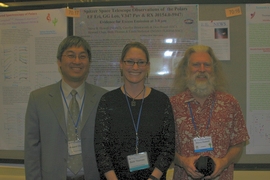Detecting Brown Dwarfs in Interacting Cataclysmic Binaries: Using Spitzer Space Telescope infrared images to determine whether the companion of the remnant star EE Eri (a white dwarf) is in fact a very low-mass object (sometimes called 'failed star') known as a brown dwarf.
Recent observations and research indicate that interacting binaries may harbor brown dwarfs (BD) as the mass donor if their orbital periods are less than about 90 minutes. One such system, EF Eri, has been proven to contain a BD mass donor (Harrison, Howell, et al, 2004 ApJ, 614, 947). After a correlation of the 2MASS database with known ultra-short period binaries, three systems have been identified that have orbital periods less than about 90 minutes and contain highly magnetic white dwarfs (similar to EF Eri) which are likely to contain brown dwarfs. In the near-IR (JHK bands), interacting binaries with magnetic white dwarfs can create complex spectral energy distributions (SED). The accretion flux can often be observed in the near-IR. In addition, the high magnetic fields (30MG) typical of polars can also contribute heavily in the near -IR in the form of cyclotron humps.
These humps are most prominent in the 6000 Angstrom to 2.5 micron range. To complete the SED or spectral picture of these interacting binaries, the longer wavelength IR needs to be added. The mass donor (whether an M star or brown dwarf) will radiate into the IR and should be clearly identifiable at wavelengths longer than those possibly contaminated. By using the Spitzer Infrared Array Camera (IRAC) the SED of the mass donor star can be isolated and the spectral type can be determined.
Cranston High School East, Cranston, Rhode Island
Allentown High School, Allentown, New Jersey
The Brown Dwarf team has published their work in ApJ!
Steve Howell has informed the Brown Dwarf group that the ApJ Letter (Ef Eri and the surrounding dust cloud) was finally accepted earlier this month.
